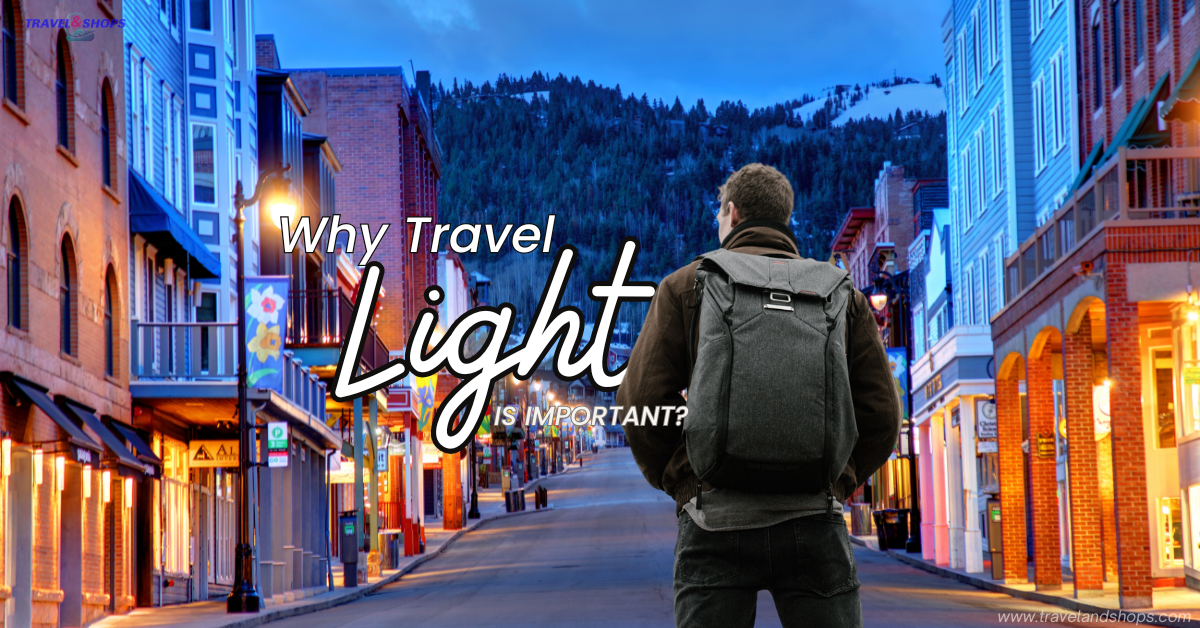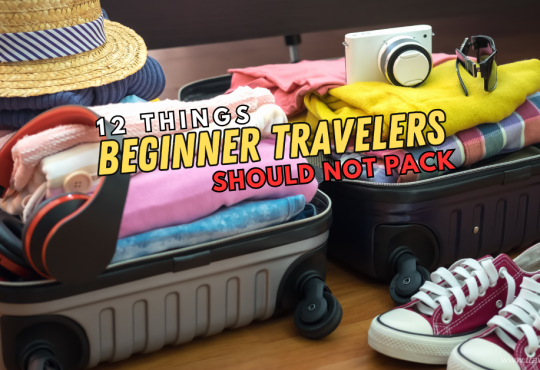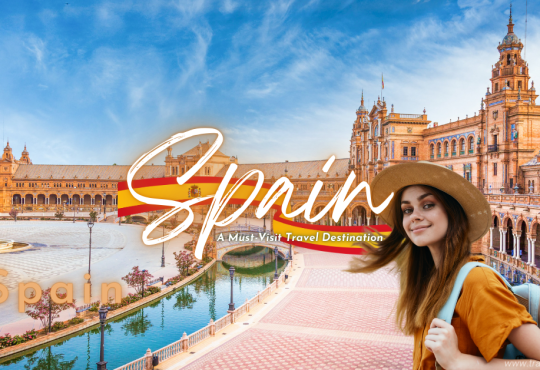
In a world where experiences matter more than material things, traveling with just a single backpack can be liberating. Gone are the days of hauling heavy luggage through crowded airports or struggling to fit bags into tiny hostel rooms. Imagine the freedom of moving easily from place to place, knowing that all your essentials are comfortably packed in one reliable backpack. But how do you make that leap to minimalism while still having everything you need?
The secret lies in choosing the right backpack, packing smartly, and embracing the trend of travel light. In this guide, we’ll dive into the essentials of traveling with just one backpack, introduce you to the 10 best travel backpacks this year, and explain why light traveling isn’t just practical—it’s a lifestyle choice. So, if you’re ready to say goodbye to bulky luggage and hello to ultimate convenience, let’s get started!
The Trend of Travel Light? The Perks of a Single Backpack
Traveling light with just a single backpack can dramatically enhance your journey, offering numerous benefits that go beyond mere convenience. Here are some key reasons why adopting this minimalist approach is advantageous:
- Increased Mobility and Freedom: When you travel with only a backpack, you gain unmatched mobility. Navigating through crowded airports, train stations, or busy city streets becomes significantly easier without the burden of wheeled luggage or multiple bags. You can move quickly, hop on and off public transport, and seamlessly transition between locations. This flexibility allows for spontaneous adventures and the ability to adapt your plans without being weighed down.
- Simplicity and Reduced Stress: Carrying fewer items simplifies the travel experience. With a single backpack, there’s less to keep track of, which can reduce anxiety associated with lost bags or forgotten items. You can focus on enjoying your trip rather than worrying about managing multiple bags. This simplicity also translates into quicker packing and unpacking at your accommodation, enabling you to spend more time exploring.
- Cost Savings: Many airlines charge extra fees for checked luggage, especially on budget flights. By traveling with a single backpack that meets carry-on size requirements, you can avoid these costs altogether. This approach not only saves you money but also makes boarding and disembarking from flights more efficient. Additionally, with less baggage, you may avoid tipping or transporting large suitcases, further cutting down on travel expenses.
- Encouragement to Pack Wisely: Traveling with only one backpack encourages you to carefully consider what you truly need. This mindful packing leads to a more organized and intentional travel experience. By focusing on essential items and versatile clothing, you minimize waste and ensure that you only carry what you will actually use. This practice can also foster a sense of resourcefulness, enhancing your overall travel skills.
- Enhanced Travel Experience: Traveling light allows for a more immersive travel experience. With fewer possessions to manage, you can be more present and engaged in your surroundings. This approach fosters a greater connection to the places you visit, as you’re not distracted by the logistics of handling multiple bags. You’re free to take spontaneous detours, participate in local activities, and fully embrace the culture of your destination.
- Environmental Impact: Light travel can also have positive environmental implications. By minimizing your luggage, you contribute to reduced fuel consumption on planes and other transport. Additionally, many of the best travel backpacks are made from eco-friendly materials, which aligns with sustainable travel practices. Choosing to travel light can therefore be a small yet meaningful step towards reducing your carbon footprint while enjoying your adventures.
- Better Storage Solutions: Modern travel backpacks often come equipped with smart storage solutions that maximize space and organization. Many include dedicated compartments for laptops, shoes, and clothing, ensuring that everything has a place. This efficient design helps you maintain order, making it easy to find what you need when you need it.
Traveling light with a single backpack not only streamlines your travel experience but also enhances your enjoyment and connection to the journey. By embracing this approach, you can navigate the world with greater ease, allowing for a richer and more memorable adventure. For more insights on the benefits of light travel, you can explore articles from travel experts and bloggers who advocate for this minimalist approach.
How to Pack a Single Backpack
Packing a single backpack effectively requires strategy and organization to maximize space and maintain easy access to your essentials. Here’s a step-by-step guide on how to pack your backpack for optimal efficiency:
- Select the Right Gear: Begin by choosing the right backpack that fits your needs, focusing on one that is lightweight, durable, and has multiple compartments. A capacity of around 40-50 liters is usually ideal for a week-long trip.
- Lay Out Your Items: Before packing, lay out all the items you plan to take. This gives you a clear visual of what you have and helps you determine what is essential. Organize similar items together, such as your clothes, toiletries, and electronics.
- Use Packing Cubes: Invest in packing cubes to keep your items organized. They help compress clothing and make it easier to find what you need without emptying your entire backpack. Consider categorizing items by type or day (e.g., pants in one cube, shirts in another) to streamline your packing process.
- Roll Your Clothes: Rolling clothes instead of folding them can save space and reduce wrinkles. This method allows you to fit more into your backpack and is especially effective for t-shirts, pants, and lightweight fabrics. For bulkier items like jackets, consider using compression bags to minimize their size further.
- Utilize All Spaces: Make the most of every available space in your backpack. Place smaller items in the gaps between larger items, and use any exterior pockets for items you need quick access to, such as snacks, travel documents, or a water bottle. Pack heavier items like shoes at the bottom to maintain balance.
- Organize Electronics and Toiletries: Keep your electronics and toiletries organized in separate compartments or pouches to avoid spills and tangles. Use a dedicated, padded compartment for electronics like laptops and tablets, and opt for travel-sized toiletries to save space.
- Pack an Emergency Kit: Include a small emergency kit with essentials like a first aid kit, a portable charger, and basic toiletries. Having these items readily accessible can save you trouble in case of unexpected situations during your travels.
- Leave Room for Souvenirs: If you plan to buy souvenirs or additional items during your travels, leave a little extra space in your backpack. This foresight prevents the need to carry an extra bag and keeps your packing light and manageable.
- Practice Zipping It Up: After packing, practice zipping up your backpack. If it’s difficult to close, reassess your packing strategy. It may be necessary to remove or rearrange some items to achieve a comfortable fit.
- Adjust Your Pack: Before you head out, adjust the straps of your backpack for a comfortable fit. Ensure that the weight is evenly distributed to avoid strain on your shoulders and back. A well-fitted backpack can make a significant difference in how you feel while traveling.
By following these steps, you can pack your single backpack effectively, making your travel experience smoother and more enjoyable. For more detailed packing strategies and tips, check out travel guides and articles on efficient packing techniques.
10 Best Travel Backpacks Worth Investing This 2025
Choosing the best travel backpack makes all the difference in a comfortable journey. Here’s a rundown of the top-rated backpacks for 2025 that strike the perfect balance between size, functionality, and durability.
1. Osprey Farpoint 40 – Approx. $185 USD
Known for its durability, the Osprey Farpoint 40 is carry-on friendly, offers ample organization, and is perfect for versatile travel scenarios. Its updated design features recycled fabric, improved harness adjustments, and a robust suspension system ideal for longer wear, making it a favorite for budget backpackers and digital nomads alike. Prices may vary slightly based on color and seller.
- Capacity & Size: 40 liters, meets most airline carry-on requirements.
- Key Features: Lightweight, spacious, and designed with ergonomic shoulder straps and hip belts. The “stowaway” feature allows you to tuck away the shoulder straps, converting it into a duffel-style bag.
- Who It’s Best For: Perfect for backpackers who need a durable pack for long walks, hikes, or train-hopping. Great for adventure travelers who prioritize comfort.
- Pros: Comfortable hip belt for weight distribution, highly durable, excellent for both urban and rural travel.
- Cons: Lacks a dedicated laptop sleeve, so it may not be ideal for digital nomads.
2. Nomatic Travel Pack – Around $299 USD
This compact but spacious pack features innovative compartmentalization for tech, toiletries, and essentials. It has a clamshell design, waterproof zippers, and is one of the pricier options for business travelers and digital nomads who want a sleek, professional look. You may find some deals occasionally, but the standard price remains on the higher end due to its premium materials.
- Capacity & Size: Expands from 20 to 30 liters.
- Key Features: Sleek, modern design with a waterproof coating and a flexible compartment system. Has dedicated tech pockets, including a quick-access laptop pocket.
- Who It’s Best For: Ideal for business travelers and digital nomads who need a tech-friendly bag for work and travel.
- Pros: Expandable, waterproof, and loaded with organizational features.
- Cons: On the heavier side for its size, and the minimalist design may not appeal to all.
3. Tortuga Outbreaker 45L – About $399 USD
Designed with maximum organization in mind, this backpack has custom-fit suspension and waterproof sailcloth fabric, making it excellent for extended trips. Although it’s one of the most expensive options, frequent travelers and minimalists appreciate the value for both city and rugged travel.
- Capacity & Size: 35 liters.
- Key Features: Opens like a suitcase, with clamshell-style zippers that allow for easy packing and unpacking. Includes a padded laptop compartment.
- Who It’s Best For: Ideal for urban explorers who prefer a well-organized and easy-to-access pack.
- Pros: Comfortable to wear, easy to pack and access items, compact design.
- Cons: Limited color options and a bulkier look compared to some sleek designs.
4. Patagonia Black Hole 32L – Approximately $169 USD
Known for its sustainable construction, this durable, weather-resistant bag has a simple design and ample room for essentials. While smaller than some on this list, it’s popular for eco-conscious travelers who need a carry-on for shorter trips.
- Capacity & Size: 32 liters.
- Key Features: Made from durable, water-resistant recycled materials with plenty of interior and exterior compartments.
- Who It’s Best For: Great for eco-conscious travelers and outdoor adventurers who need a durable, weather-resistant pack.
- Pros: Eco-friendly, sturdy, and weatherproof.
- Cons: Smaller capacity than some other options, which may limit multi-week travel.
5. Peak Design Travel Backpack 45L – Roughly $299 USD
This bag is beloved by photographers and travelers alike for its modular system and convenient camera cube options. With its sleek, water-resistant build, it offers ample space and flexibility, ideal for travelers who like to mix adventure with business.
- Capacity & Size: Expandable from 30 to 45 liters.
- Key Features: Customizable internal compartments, weatherproof zippers, and reinforced fabric. Tailored for photographers with padded, customizable dividers.
- Who It’s Best For: Photographers, creatives, and travelers with specialized packing needs.
- Pros: Highly durable and flexible, with customizable storage for tech and camera gear.
- Cons: Heavier than average, may not be necessary if you don’t need custom compartments.
6. REI Co-op Ruckpack 40 – Around $149 USD
REI’s Ruckpack is a reliable choice for budget-conscious travelers, with ample compartments, a rain cover, and supportive back padding. It’s perfect for those who don’t need many extra features but still want durability and function at a lower price point.
- Capacity & Size: 40 liters.
- Key Features: Affordable, with water-resistant fabric, and multiple internal compartments. Has a zippered laptop sleeve and a rain cover.
- Who It’s Best For: Budget travelers who want a sturdy, reliable backpack without breaking the bank.
- Pros: Value for money, versatile, rain cover included.
- Cons: Simpler design, lacks some premium features like anti-theft pockets.
7. Aer Travel Pack 3—Around $279 USD
The Aer Travel Pack 3 offers a sleek, minimalist design with a spacious interior. It includes a ventilated shoe compartment and laptop sleeve, perfect for travelers looking to keep everything organized without fuss.
- Capacity & Size: 35 liters.
- Key Features: Stylish minimalist design, ventilated shoe compartment, and multiple tech pockets. Ideal for travelers who want a functional yet fashionable backpack.
- Who It’s Best For: Urban travelers, business professionals, and those who want a streamlined design.
- Pros: Sleek design, well-organized compartments, good for business trips.
- Cons: Limited capacity for long-term travel, higher price point.
8. Tomtoc Navigator Travel Backpack—Around $80 USD
For travelers who appreciate thoughtful organization and durability in a compact size, the Tomtoc Navigator Travel Backpack stands out. This backpack is designed with a versatile 40-liter capacity and features compartments for tech and personal items, making it a solid choice for light, organized travel. Its sturdy, padded harness system keeps things comfortable during long hauls, and the ventilated back panel prevents overheating.
- Capacity & Size: 40 liters
- Key Features: Durable nylon construction, laptop compartment, adjustable sternum strap, and water-repellent exterior.
- Who It’s Best For: Great for digital nomads or travelers who prefer organized storage with quick-access pockets for on-the-go convenience.
- Pros: Multiple compartments for easy organization, comfortable straps, compact yet spacious.
- Cons: A bit saggy when not fully packed.
9. Thule Subterra 34L Backpack—Around $159 USD
The Thule Subterra 34L is a versatile travel backpack designed for efficient organization on the go, making it ideal for weekend getaways or shorter business trips. It offers a 34-liter capacity with a sleek, durable design and multiple features aimed at providing convenience for both travel and daily use.
- Capacity & Size: 34 liters.
- Key Features: This backpack includes a removable packing cube, making it easier to pack and unpack clothing. It also features a padded laptop sleeve (fits up to 15.6-inch laptops), a “PowerPocket” to manage cords between your device and charger, and both top and side access for added convenience.
- Who It’s Best For: Suitable for travelers needing an efficient bag for shorter trips or business travel.
- Pros: Stylish and organized layout with quality build, designed for easy laptop access.
- Cons: Limited space for longer trips, and lacks a water-resistant coating.
10. GoRuck GR2—Around $475 USD
The GoRuck GR2 is built for travelers who want a durable, minimalist backpack that can handle rugged adventures. With military-grade materials and a highly structured design, it’s perfect for those looking for a robust pack to withstand frequent or intense use. It features a 40-liter capacity, making it suitable as a carry-on for most airlines, and includes multiple compartments, allowing for efficient organization of travel essentials. This bag’s unique, heavy-duty features—such as bombproof construction, thick shoulder straps, and a built-in laptop compartment—cater to adventure seekers or those who require an ultra-resilient bag.
- Capacity & Size: 40 liters
- Key Features: Heavy-duty 1000D Cordura nylon construction, multiple compartments for organized packing, and a dedicated laptop sleeve.
- Who It’s Best For: Great for those who value durability and need a backpack capable of rough handling in challenging environments.
- Pros: Exceptionally durable, organized storage, fits as a carry-on.
- Cons: On the heavier side and lacks some travel-specific features like a hip belt.
Bonus: Popular and trendy for light travelers
Pakt Travel Backpack (45L)—Around $345 USD
The Pakt Travel Backpack is designed for those who want a convenient and stylish bag for urban and international travel. The 45L model offers spacious dual compartments, allowing you to organize items separately. The clamshell opening makes it easy to pack like a suitcase, while the 16-inch laptop compartment is padded for added protection. Crafted from recycled, water-resistant nylon, it’s both durable and environmentally friendly.
- Capacity & Size: 45 liters.
- Key Features: Clamshell design for easy packing, a padded laptop sleeve, daisy chain system for clip-in pouches, and multiple organizational compartments.
- Best For: Travelers seeking an efficient, eco-friendly, mid-size carry-on with excellent organization features for city and air travel.
- Pros: Compact design, sustainable materials, well-organized compartments.
- Cons: Limited capacity for extended trips or those needing more storage.
Why the Best Travel Backpacks Make Light Travel Easy
Tips to Embrace Light Travel
Adopting a light travel approach can transform your travel experience, making it more enjoyable, stress-free, and efficient. Here are some practical tips to help you embrace the art of traveling light:
- Choose the Right Backpack: Start with a quality travel backpack that suits your needs. Look for one with a capacity of around 40-50 liters, which should be ample for a week-long trip. Ensure it has a comfortable harness system, multiple compartments, and is made from durable materials. Brands like GoRuck, Thule, and Pakt offer excellent options designed for efficiency and comfort.
- Plan Your Outfits: Before you pack, plan your outfits. Choose versatile clothing items that can be mixed and matched to create different looks. Stick to a color palette so that everything goes together. Fabrics like merino wool are breathable, odor-resistant, and can be worn multiple times without needing a wash. This not only reduces the number of items you pack but also keeps your wardrobe light.
- Pack Smart: Use packing cubes to organize your clothes and accessories. These can help compress items and maximize space in your backpack. Roll your clothes instead of folding them to save space and reduce wrinkles. Additionally, consider packing a lightweight rain jacket that can double as a windbreaker, saving you from needing separate layers.
- Limit Footwear: Footwear can take up significant space in your backpack. Aim to bring no more than two pairs of shoes: one for daily wear and one for special occasions or outdoor activities. Choose shoes that are comfortable for walking and versatile enough to match multiple outfits.
- Utilize Technology Wisely: Instead of bringing multiple devices, consider consolidating your tech. For instance, a smartphone can serve as a camera, e-reader, and GPS. Download necessary apps before your trip and consider offline maps to save space and battery life. Also, investing in a portable charger can keep your devices powered without needing extra cables and adapters.
- Be Mindful of Toiletries: Toiletries can quickly add bulk to your backpack. Opt for travel-sized containers or transfer your essentials into smaller bottles. You might also consider solid toiletries like shampoo bars, which are compact and don’t leak. Many accommodations provide basic toiletries, so check in advance to avoid bringing unnecessary items.
- Adopt a Minimalist Mindset: Embrace a minimalist approach to packing. Ask yourself if each item is essential or if it can be left behind. If you’re unsure, think about how often you’ll use an item during your trip. The goal is to take only what you truly need.
- Leave Room for Souvenirs: If you’re planning to bring back souvenirs, pack with that in mind. Leave a little extra space in your backpack to accommodate any purchases you make along the way. This will help prevent the need for extra bags or worrying about exceeding carry-on limits.
- Practice Before Your Trip: If you’re new to light travel, practice packing light before your trip. Try going on a short weekend getaway with just your backpack to see how much you truly need. This trial run will help you refine your packing strategy and boost your confidence in traveling light.
- Stay Flexible: Finally, remain flexible and open to adapting your plans. Sometimes, the best experiences come from spontaneity. By traveling light, you can more easily change your itinerary or make last-minute decisions without being burdened by excess luggage
Embracing light travel can enhance your overall travel experience by making it more manageable and enjoyable. By following these tips, you can explore new destinations without the burden of excessive baggage, leaving you free to focus on making unforgettable memories. For more information on effective light travel strategies, check out resources from travel experts and bloggers
Traveling Light Is the Way Forward
Travel light with a travel backpack is more than a trend; it’s a movement toward simplicity, mobility, and experiencing the world without the weight of unnecessary belongings. With the right backpack and some thoughtful packing, you can have everything you need at your fingertips without the burden of extra bags. Whether you’re off on a short city escape or a month-long backpacking adventure, light travel offers a sense of freedom and flexibility that is hard to match.
So next time you plan your adventure, consider the benefits of packing light and choosing the best travel backpack that suits your needs. A world of ease and simplicity awaits, where less truly means more. The journey becomes more about the experiences and less about the logistics, letting you immerse yourself fully in every moment. Safe travels, and happy packing!





